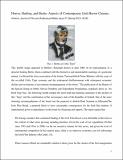| dc.contributor.author | Crosson, Seán | |
| dc.date.accessioned | 2016-08-23T13:58:51Z | |
| dc.date.available | 2016-08-23T13:58:51Z | |
| dc.date.issued | 2012 | |
| dc.identifier.citation | Crosson, S. (2012) ' Horror, Hurling, and Bertie: Aspects of Contemporary Irish Horror Cinema '. Kinema, (37):65-83. | en_IE |
| dc.identifier.issn | 1192-6252 | |
| dc.identifier.uri | http://hdl.handle.net/10379/5987 | |
| dc.description.abstract | In Ireland, generic international cinematic forms have provided an important means through which filmmakers have attempted to tell Irish stories while engaging international audiences. However, in general Irish filmmakers have been less inclined until recent years to turn to that most overused and familiar of film genres, the horror. Indeed, its over familiarity may well have been a contributory factor in directors' hesitancy to adopt the horror form for their films until the mid-1990s. Since then, and particularly from the early 2000s, Irish filmmakers have increasingly turned to horror as a form through which to explore aspects of Irish society, culture, history and, indeed, their representation. While reflecting providing an overview of these films, this article focuses in particular on a feature film sometimes credited kicking off the most recent series of Irish horror films, Conor McMahon's Dead Meat (2004), a film preceded by his 2001 award-winning short The Braineater. While Dead Meat and The Braineater are heavily indebted to previous international horror work, including films by Sam Rami, Peter Jackson, George A. Romero and Lucio Fulci, a striking feature in both is the use of elements and motifs associated with indigenous Irish culture and sport, in particular the Gaelic game of hurling, within their narratives. These films also, in common with other recent horror works, reject and critique previous touristic depictions of Ireland (an important determinant of representations of Ireland in international productions throughout the 20th century) while providing an 'allegorical moment' both for the exploration of trauma in Ireland's distant and more recent past and a critique of Celtic Tiger Ireland itself. | en_IE |
| dc.format | application/pdf | en_IE |
| dc.language.iso | en | en_IE |
| dc.publisher | University of Waterloo, Department of Fine Arts (Film Studies) | en_IE |
| dc.relation.ispartof | Kinema | en |
| dc.rights | Attribution-NonCommercial-NoDerivs 3.0 Ireland | |
| dc.rights.uri | https://creativecommons.org/licenses/by-nc-nd/3.0/ie/ | |
| dc.subject | Film studies | en_IE |
| dc.subject | Cinema | en_IE |
| dc.subject | Horror | en_IE |
| dc.subject | Hurley | en_IE |
| dc.subject | Bertie Aherne | en_IE |
| dc.title | Horror, hurling, and Bertie: aspects of contemporary Irish horror cinema | en_IE |
| dc.type | Article | en_IE |
| dc.date.updated | 2016-08-23T13:41:18Z | |
| dc.local.publishedsource | http://www.kinema.uwaterloo.ca/article.php?id=513&feature | en_IE |
| dc.description.peer-reviewed | peer-reviewed | |
| dc.internal.rssid | 2435391 | |
| dc.local.contact | Seán Crosson, Huston Film School, Nui, Galway. 5687 Email: sean.crosson@nuigalway.ie | |
| dc.local.copyrightchecked | No | |
| dc.local.version | ACCEPTED | |
| nui.item.downloads | 860 | |


